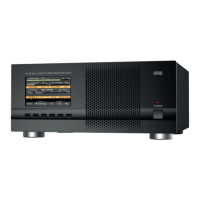
 Loading...
Loading...
Do you have a question about the Acom 1200S and is the answer not in the manual?
| Frequency Range | 1.8 - 54 MHz |
|---|---|
| Output Power | 1200 W PEP |
| Modes | SSB, CW, AM, FM, RTTY |
| Power Supply | 220 - 240 V AC, 50/60 Hz |
| Cooling | Forced air cooling |
| Input Impedance | 50 ohms |
| Output Impedance | 50 ohms |
| Tube | 4CX800A |
| Harmonic Suppression | Harmonics – better than 50dB below rated PEP output. |
Explains the contents, purpose, and distribution of the user manual.
Provides an overview of the ACOM 1200S linear power amplifier.
Details how to get support and contact ACOM for help.
Lists the items that come with the ACOM 1200S amplifier.
Highlights the main capabilities and technologies of the amplifier.
Defines safety terms and outlines hazards for safe operation.
Guides users through inspecting the amplifier after delivery.
Explains the amplifier's power supply voltage range and operation.
Provides guidance on choosing a suitable place for the amplifier.
Details how to connect the amplifier to the station's radio equipment.
Explains how to connect peripherals and configure user settings.
Describes the initial power-on state and the standby mode.
Details the buttons, LEDs, and display on the amplifier's front panel.
Guides the user through the first power-up sequence.
Explains the information displayed on the amplifier's main screen.
Explains how to use the amplifier's control buttons and navigate menus.
Outlines procedures for testing the amplifier installation.
Explains how to switch between operating and standby modes.
Details how the amplifier handles frequency bands and coverage.
Describes using an external antenna tuner with the amplifier.
Explains the various protection mechanisms within the amplifier.
Details how to view amplifier performance parameters.
Describes service functions for checking and adjusting amplifier circuits.
Explains how to configure CAT/AUX interface settings for transceivers.
Covers user-configurable settings like auto exit and display brightness.
Explains how to access and interpret fault logs for troubleshooting.
Describes how to reset amplifier settings to factory defaults.
Details remote control using the ACOM eBox Ethernet device.
Explains remote control using the RS-232 serial interface.
Outlines regular checks for connections, cleanliness, and SWR.
Provides instructions on how to clean the amplifier's exterior and vents.
Details the procedure for safely replacing primary mains fuses.
Explains how to use fault codes for diagnosing issues.
Covers firmware versions, prerequisites, and update procedures.
Lists the technical specifications and performance parameters of the amplifier.
Lists the key functionalities and control methods of the amplifier.
Details environmental requirements and procedures for storing and shipping.
Provides guidance on responsible disposal and recycling of the product.